Before we start this week, the Thor team bids a fond farewell to Bart Bishop, who’s pursuing other writing opportunities (as well as having a real life!), and will no longer be able to contribute his incisive reviews and commentaries to this column. You’ll be missed, Bart, and don’t be a stranger.
Spaceman #6 ($2.99, Vertigo)
By D.S. Randlett
It’s been said before, but the partnership between Brian Azzarello and Eduardo Risso is unlike anything else in comics. The two creators are so in sync with each other that when they produce any work at all, it feels like the work of one creator, like one distinct creative voice. It’s easily one of the best partnerships in comics, and I look forward to their work almost as much as I do some of the industry’s heavy hitters.
What’s been fascinating over the past few months is seeing the hype build for Brubaker and Philip’s Fatale. Every time a new issue comes out, it seems like all of the comic book people on Twitter and elsewhere get amped up and scramble to find shops that still have the latest issue in stock. Fatale is a good book and deserves every ounce of attention that it gets, and it’s heartening to see people excited for not just a comic book, but a comic book that’s been set up as a celebration of noir and horror by two genuinely great creators at the top of their game. What’s odd is that there’s been so little hype for Spaceman, which is also a noir-infused story by two creators at the top of their game.
Spaceman reads like like a very sly combination of noir, Snow Crash, and John Steinbeck. There’s something extremely tough and unforgiving about the world of this story. It appears that the global economy has well and truly tanked and sea levels have risen, giving way to a stratified class system in which most everyone lives in what can best be described as squalid dock slums in the ruins of New York City while the elect live in a walled off and luxurious supercity, and everyone speaks a strange internet Pidgin. It’s a world where money is an abstract number concept, where you can either get paid for labor (like most everyone) or coast along on the fame you garner from your reality show. It’s not hard to see what Azzarello and Risso are getting at here: the culture after the collapse will merely be an accentuation of the current culture.
For all of the scifi satire trappings, the story itself isn’t focused on those things so much. The jaundiced view of this particular universe is merely a backdrop to tell a story that, at bottom, is about people trying to be good or better people. The story follows Orson, a genetically engineered human who was created to terraform Mars before the collapse (in the world of Spaceman called “The Rise”, presumably on account of the rising sea levels) who has been cut off from the purpose that he was created for. The story unfolds on two fronts. One takes place in Orson’s past, during his sole mission to Mars, and one takes place in his present. Both are pretty hairy. In his past, he’s been witness to a murder over rights to a Martian gold claim, and in his present he’s trying to get Tara, a young reality star (she’s been adopted by a Brad and Jen style celebrity-philanthropist couple) who’s been kidnapped.
There’s nothing really too original about his story, and so far it’s unfolded pretty predictably. But Azzarello and Risso prove themselves by finding an empathetic voice for this story. Orson might be aloof and outcast from his world, but we are not disconnected from him. He was engineered to be hardier and stronger than a normal human, but Azzarello and Risso succeed in making the character feel vulnerable despite his obvious physical strength. This is a lonely character who wants to trust people. Azzarello gives him an almost childlike quality in his dialog, while Risso captures a sort of innocence in his eyes. It’s almost impossible not to be affected by this and root for the poor guy.
There are three issues left of this series, and I’m willing to bet that back issues are in ample supply. Spaceman represents some of the best things about storytelling, comic book or otherwise, and features a truly compelling central character. This book deserves your support.
Rating: 




Out of a Possible 5 Stars
 AVX: VS #1 ($3.99, Marvel Comics)
AVX: VS #1 ($3.99, Marvel Comics)
By Devon Sanders
For years, I’ve jokingly threatened to approach Marvel about writing a comic simply titled, “FIGHT!” Its premise would’ve been a simple one. At each issue’s beginning, Marvel’s heavy-hitters; the strongest, the fastest, the most energy shooting-iest would scream, “FIGHT!!!” And keep fighting. And throwing stuff at each other. And keep on fighting. There would be ZERO reason for this comic to exist. There would be ZERO reason for these fights to occur. You would simply pick up this book knowing that this comic, in which heroes fight heroes, heroes fight villains and villains fight villains would be the most Marvel of Marvel comics. I don’t know when or where I was in a bar and got slipped some sodium thiopental but someone took my idea and made a damned summer comics event using The Avengers and The X-Men. I’m not pissed, though.
Now, in the actual 12 issue crossover event, Avengers vs. X-Men; they fight but the fights don’t really get the time to breathe that they deserve so Marvel decided to give us a six-issue mini-series to flesh out the fights. A sort of “Director’s Cut”, if you will. Hence, AVX: VS #1.
Magneto, The Master of Magnetism fights Tony Stark, Iron Man. Magnets versus iron and it should be fun but unfortunately, writer Jason Aaron, in a rare misfire, bogs it down with so much nonsensical science and over-explanation of why things are happening that it gets in the way of the book’s true purpose: fighting. Artist Adam Kubert’s work here is almost too wispy and the panel layout is a confusing and oddly lack in the grandeur needed in a book about fighting.
So much more successful is writer Kathryn Immonen and artist Stuart Immonen’s effort, a Thing vs. Namor, The Sub-Mariner. They get it. It’s another Thing vs. Namor showdown. What they hold onto here is that while it is just that, it should also be fun; it should also be ridiculous. They reference their past clashes. The Thing, a pilot, pilots a piece of an airplane Namor just threw into and fights him. Namor, an Atlantean prince, summons a gigantic, toothy fish to help him fight The Thing. The Thing hits Namor with a treasure chest. It’s a truly glorious thing. Stuart Immonen with his bold, imaginative layout and absolutely beautiful line, once again, shows why he’s one of superhero comics’ most valuable assets.
I oddly enjoyed AVX: VS #1. It’s a ridiculous, ridiculous yet unnecessary thing and in some ways, the epitome of the “event comic” phenomenon.
That said, if you do wind up picking up AVX: VS #1, do it for The Thing/Namor showdown, a solid FIVE STAR EFFORT. The Magneto/Iron Man effort… well, they both get to live to fight another day.
Rating: 




Out of a Possible 5 Stars
The Goon #39 (Dark Horse, $3.50)
By Jeb D.
Last month, The Goon #38 delivered a strong, unusually emotional entry in Eric Powell’s ongoing saga of zombies, fists, debauchery, tommyguns, excrement jokes, ghouls, demon babies and the like. Naturally, one wouldn’t expect Powell to operate in that mode for too long, so this month you’d expect things to be back to the grossouts and the silly… and you’d kinda be right, but…
Y’see, Eric Powell’s pissed. Though he professes to have had good experiences in his occasional outings with DC and Marvel, he’s another industry professional in despair at the stranglehold that corporate superheroes have on the comics scene, inhibiting the growth of other types of sequential storytelling (like, f’rinstance, comics about bad-tempered hulks who wail the hell out of slackjaws). Naturally, I’m sympathetic, though I continue to believe that the form itself is a key obstacle to new patrons (not only do I know otherwise intelligent readers that won’t even consider looking at a “graphic novel,” I also know readers of GN/trade collections that refuse to try the same material presented in the old-school “floppy/pamphlet/whatever” format). And in the back of this issue, Powell presents an eloquent essay on his views.
But sympathetic though I may be, I’m not having much success working up outrage as he illustrates his points by putting the Goon and Frankie through a series of satirical gags lampooning the familiar foibles of the comics industry: new origins, new costumes, new numberings, variant covers, dead-don’t-mean-shit resurrections, and tips for artists about cleaning up on ebay (hint: draw lots of popular characters in splash pages, and add butt-shots wherever possible). Throughout, Powell does dead-on impressions of over-the-top work from artists like Jim Lee and Frank Miller, and you can enjoy the issue on that spot-the-reference basis alone; but it’s worth noting that for all the fun and games, the brief framing sequence, with The Goon and Frankie done in Powell’s usual style, has a visual resonance that the rest of the book doesn’t share.
As I say, Powell’s earned the right to express himself, and he clearly never skimps on the effort that he puts into doing so, but in the end, I don’t know that it amounts to much beyond some nice pix and a few chuckles (which I suppose shouldn’t be taken for granted either). It’s not so much that some of the jokes date to back to 50’s era MAD parodies (there’s even a tongue-in-cheek “editor’s note” that flat-out admits that much of Powell’s parody is stuck in the past), since that’s one of the great sources of his art in the first place, or that he’s re-raising objections that dozens before him have raised; it’s just that I’ve just never before pictured Powell with an enormous shotgun, standing over a barrel brimming with fish. I certainly have no problem with his launching this assault–as an independent contractor in the field of comics, he has more of an axe to grind than I do. But not even the most incisive parody (which I’m not quite sure this is) is all that effective when it’s aimed directly at the people who already share your views, reducing what ought to sharp satire to a sequence of in-jokes: by definition, anyone reading The Goon already knows there’s life outside the Big 2, and Powell’s preaching to the (rather geeky) choir.
Rating: 




Out of a Possible 5 Stars
 Battle Scars #6 of 6 (Marvel, $2.99)
Battle Scars #6 of 6 (Marvel, $2.99)
By Jeb D.
So I’m guessing you probably think this issue wraps up what was just about the most pointless retcon/rejigger in the history of the Marvel Universe; after all, if Marvel still hasn’t figured out that reshaping their venerable comics characters to meet the expectations of a movie-going audience isn’t going to make those people into regular comics buyers, they’re probably never going to. And replacing the original Nick Fury with a guy that looks like Sam Jackson is not only cheesy and obvious, but it undermines whatever uniqueness that allowed the Ultimate Universe to stand on its own little four-color feet, where the idea originated (and which is going to take another hit when the Spider-Men crossover launches). But I believe I have penetrated its hidden motives…
This by-the-numbers action movie of a miniseries concludes this week with the now one-eyed guy-who-thought-his-name-was-Marcus-Johnson conducting the inevitable rescue of his imprisoned father, joined for the big throwdown by the Avengers. This is followed by the obligatory hospital-recovery scene where Nick Fury Senior lays the home truths on hard-headed Junior, before theoretically departing from active duty in the Marvel Universe, followed by yet another unnecessary movie tie-in as the new Fury starts his new job.
Chris Yost’s script hits its marks, and Scot Eaton, Andrew Hennessy and Paul Mounts give it probably more visual life than it warrants. So now there is absolutely no danger of any innocent moviegoer being utterly confused by a comic where the Avengers’ resident spymaster is some old white dude, which will doubtless come as a relief to many.
Do I sound cynical? Not at all… because I know what the whole point of this exercise really is: to get the original Nick Fury out of the Marvel Universe so that Garth Ennis can once more have his wicked way with the crusty superagent in his upcoming new MAX series! See, now that they’ve got a big-time movie star playing Fury onscreen, everyone can forget the legendary gaffe of George Clooney putting the kibosh on a Fury film when someone slipped him a copy of Ennis’ previous outing with the character. Instead, Ennis can make Nick the same antisocial bastard we saw in Fury and in his Punisher MAX appearances, without offending anyone’s tender sensibilities, since no one outside the established MAX/Ennis fanbase will ever see it– I can’t wait. Well played, Mr. Quesada!
Rating: 




Out of a Possible 5 Stars